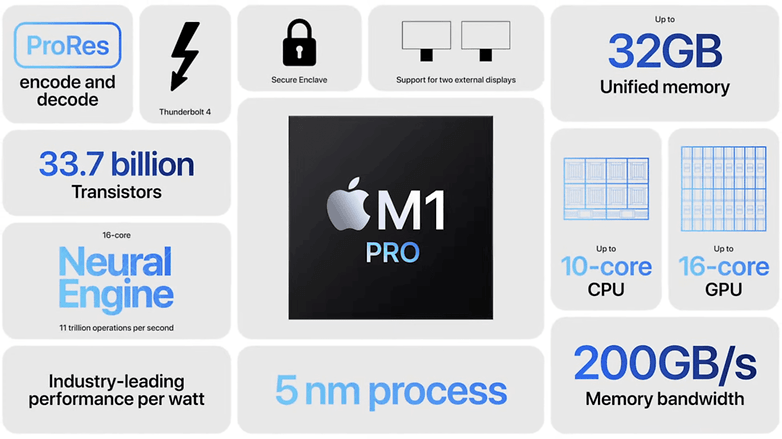Apple M1 Pro/Max: New SoCs with 10 cores make Intel obsolete

Apple has done as expected: the US computer company has just unveiled the "Pro" and "Max" variants of its ARM SoC intended for powerful PCs. The Apple M1 Pro and Max, respectively, will be significantly larger than their predecessor and will once again be manufactured on a 5-nanometer scale.
Apple has just unveiled the new Apple M1 Pro and Apple M1 Max, introducing a significantly larger and, more importantly, significantly more powerful variant of the M1, with 33.7 and 57 billion transistors respectively. The chips will be used in the new MacBook Pro models and new desktop systems. Apple makes an unusual step: the RAM sits on the same board as the SoC, so that the distances between the memory and the heart of the computer are extremely short.
- Apple AirPods 3 come with Pro features - and Pro price
- Apple Music Voice: A new way to listen to music
Apple M1 Pro and Max both have ten-core CPUs
The difference between the two new variants of the Apple M1 is not in the core count and performance of the CPU, because they have two power-saving and eight high-power cores in both versions, but in the GPU and memory bandwidth of 200 for the M1 Pro and 400 GB/s for the M1 Max. The graphics unit of the M1 Pro has 16 cores, while the M1 Max has 32 graphics cores. This increases the size of the Max model enormously. It is conceivable that the clock rates also differ.
32 or 64 gigabyte unified memory
There is also a difference in the memory: The M1 Pro supports a maximum of 32 gigabytes, while the M1 Max even allows 64 GB. Apple always refers to "Unified Memory", which is a custom package designed by Apple with 256 or 512 bit memory bandwidth and LPDDR5 RAM.
As for the graphics performance of the two chips, Apple spoke of up to 10.4 TeraFLOP for the M1 Max with its 32 GPU cores and 4096 Execution Units, while the "small" Apple M1 Max "only " reaches 5.2 TeraFLOP. Whether the graphics units in Apple's new devices can keep up with the integrated GPUs of other PC CPUs remains to be seen.

Other features of the new Apple SoCs for more powerful systems include a Neural Engine for handling AI data, a dedicated Media Engine for hardware-accelerated processing of image and video data. This should allow for significant performance gains even in applications that were actually designed for Intel-based Macs. There are also various controllers for Thunderbolt 4 and other external connections.
Double the performance of the Core i9 MacBook Pro
In general, Apple promises a powerful performance increase, although the company mostly made the comparison only to its own Apple M1. For example, the GPU alone on the M1 Max is already said to have four times the performance of the M1, while video encoding is twice as fast. Apple is mainly touting being able to achieve significantly better performance per watt than would be possible with current x86-based notebooks.
In terms of pure CPU performance, Apple claims that the M1 Pro and M1 Max are each on par - offering around 3.7 times the performance of a MacBook Pro 13-inch with an Intel Core i7 CPU, and up to two times the performance of a MacBook Pro 16-inch with an Intel Core i9 CPU. Graphics performance is even said to see an increase of up to 13 times, depending on which Intel Mac you base it on.

Depending on the chip, the new Apple SoCs are apparently supposed to work with a maximum power consumption of a good 30 or 60 watts, which would actually be new standards for ARM chips, at least in the PC context. As so often, Apple was vague: the M1 Max offers the same performance as a high-end notebook with an x86 platform, but consumes 100 watts less energy, they said.
Are you considering of getting the new MacBooks? Let us know below!















In this period I am thinking of buying a new PC, the one I have should be retired, I have had it for quite some time, even if it works fine now. But seeing the performance of the new M1 Pro and M1 Max, I'm starting to think more seriously about choosing a laptop, which would have much more processing power than the old PC. For financial reasons I'll have to stick to the "old" M1 (it's only a year old and already "old" ?!).
I'm absolutely impressed with the performance of the new processors, I was expecting an announcement about an eventual M2(!) or something like that, but maybe that will be next year. So far the Pro and Max are performing hard to match, and I think they have even more potential, we need to keep watching them.
RISC vs CISC is reborn. I do prefer RISC generally, just not with Apple involved. Remember, Apple's last RISC endeavor dead-ended when the PowerPC chips couldn't scale to what Intel was doing.
Ah, for the Unix days on Sun Sparcstations. I would like to see how those systems would have evolved given the tech progression since.
It seems like Apple has pretty much brute forced the solution to the PowerPC problem by a) having a wide ecosystem and user base that will just buy its products (thus developers are forced to make specialized software) and b) they can pretty much emulate anything they want from the x86 platform without much loss to performance, yet. Also the fact that x86 seems to be hitting roadblocks in performance gains/generation is not helping. Still they have not used HMP yet which admittedly will be a can of worms but AMD openly discussed it two days ago. Personally, i find it interesting that in order to maintain efficiency Apple pulled the HMP card out of the drawer. Both intel and AMD have yet to go that direction, so is Apple desperate for better efficiency numbers? What kind of challenges will those bring to software? Lots of questions remaining from today.
For the Unix days unfortunately i wasnt even born yet so i dont have much to add. With a quick search tho i did find out that the RISC based SPARC processors were still developed up until 2017 for server usage so you may be interesting in looking into that :)
There's been a lot of crossing of concepts into each ISA over the years and chip design has overcome many of the earlier bottlenecks. It's not the issue it once was, truly.
-
Admin
-
Staff
Oct 19, 2021 Link to commentOracle's hability to kill technologies worked pretty well with Sun's assets:
- Sparc
- Solaris
- MySQL
- Java (lol)
...
as for "RISC" vs "CISC", the processors' scaling isn't really related to the complexity of the instruction set, but rather the architecture and the will to scale that for a specific market.
IBM/Motorola/Freescale didn't bother to set enough resources for Apple's desktops (which sell in larger numbers today), besides falling behind Intel in the foundry space (which was later sold to Global Foundries).
Intel tried to court Apple with special SKUs (eg. Broadwell and Iris Pro-UHD-Pro-Max-Pro-Turbo), but they also started falling behind in the foundry space.
Now that Apple is TSMC's premier partner (Qualcomm and Nvidia having to resort to Samsung Foundry), and with the Ax SoCs pretty much established, they can fund TSMC's processes' improvements and reap the benefits in both mobile and desktop SoCs.